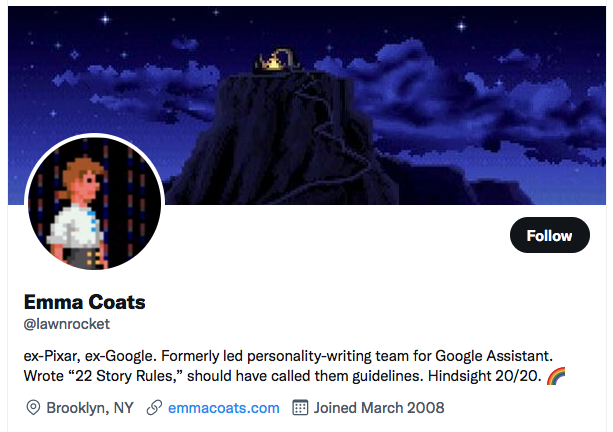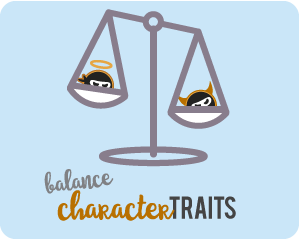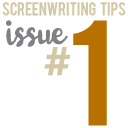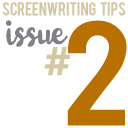30 Screenwriting Tips to Make Your Writing Seriously Amazing
by Noi Sabal • January 18, 2023
Okay – we know what you’re thinking; how can some screenwriting tips help me become a better screenwriter? What can a list of writing tips do to help me understand how to write a good screenplay?
Well, when you’re getting the tips from a storyboard artist at Pixar, one of the greatest storytelling studios EVER, you will learn a whole lot about Story. So we’re kicking off our screenwriting tip list with 22 incredibly insightful guidelines from a veteran story artist from Pixar.
In this article, we’ll explore the origins of those now-famous “Pixar 22 Storytelling Rules” and then add more in-depth screenwriting tips to round out our big fat list of 30 things you can do to make your script more professional.

The 22 Pixar Storytelling “Rules” and Story Structure
In 2011, a Pixar story artist named Emma Coats wrote a series of screenwriting tips she’d learned while working on movies such as Brave, Up, and Monsters University.

Emma Coats
@lawnrocket
ex-Pixar, ex-Google. Formerly led personality-writing team for Google Assistant. Wrote “22 Story Rules,” should have called them guidelines. Hindsight 20/20. 🌈
Tweeted initially as the “22 Story Rules” between March 26th and May 24th, Emma shared amazingly insightful tips on story, character, and theme. These 22 “rules” have gone on to be shared hundreds, if not thousands, of times by screenwriters interested in elevating their writing.
But! Get this — it turns out there were actually twenty-THREE tweets. So we did a bunch of digging, found all of the original 22 screenwriting tips, and also have the often-omitted 23rd #storybasics tweet from Emma.
To kick off our list of 30 Screenwriting Tips, here is a video and written transcript of Emma’s 23 super-helpful storytelling and screenwriting tips.
Watch the video above for screenwriting tips on:
- story structure
- character development
- theme
- stakes
- goals
- how to surprise an audience (and reader!)
The 22 Pixar Storytelling Rules
And here is an easy-to-read list of the story guidelines to help when writing a movie:
Emma Coats’ 23 Tweets of Screenwriting Tips
#1: You admire a character for trying more than for their successes. see on twitter
#2: You gotta keep in mind what’s interesting to you as an audience, not what’s fun to do as a writer. They can be v. different. see on twitter
#3: Trying for theme is important, but you won’t see what the story is actually about til you’re at the end of it. Now rewrite. see on twitter
#4: Once upon a time there was ___. Every day, ___. One day ___. Because of that, ___. Because of that, ___. Until finally ___. see on twitter *NOTE below*
#5: Simplify. Focus. Combine characters. Hop over detours. You’ll feel like you’re losing valuable stuff but it sets you free. see on twitter
#6: Come up with your ending before you figure out your middle. Seriously. Endings are hard, get yours working up front. see on twitter
(The next one is actually #7, but was tweeted as #6)
#6: What is your character good at, comfortable with? Throw the polar opposite at them. Challenge them. How do they deal? see on twitter
#8: Finish your story, let go even if it’s not perfect. In an ideal world you have both, but move on. Do better next time. see on twitter
#9: When you’re stuck, make a list of what WOULDN’T happen next. Lots of times the material to get you unstuck will show up. see on twitter
#10: Pull apart the stories you like. What you like in them is a part of you; you’ve got to recognize it before you can use it. see on twitter
#11: Putting it on paper lets you start fixing it. If it stays in your head, a perfect idea, you’ll never share it with anyone. see on twitter
#12: Discount the 1st thing that comes to mind. And the 2nd, 3rd, 4th, 5th – get the obvious out of the way. Surprise yourself. see on twitter
#13: Give your characters opinions. Passive/malleable might seem likable to you as you write, but it’s poison to the audience.see on twitter
#14: Why must you tell THIS story? What’s the belief burning within you that your story feeds off of? That’s the heart of it.see on twitter
#15: If you were your character, in this situation, how would you feel? Honesty lends credibility to unbelievable situations. see on twitter
#16: What are the stakes? Give us reason to root for the character. What happens if they don’t succeed? Stack the odds against. see on twitter
#17: No work is ever wasted. If it’s not working, let go and move on – it’ll come back around to be useful later. see on twitter
#18: You have to know yourself: the difference between doing your best & fussing. Story is testing, not refining. see on twitter
#19: Coincidences to get characters into trouble are great; coincidences to get them out of it are cheating. see on twitter
#20: Exercise: take the building blocks of a movie you dislike. How d’you rearrange them into what you DO like? see on twitter
#21: You gotta identify with your situation/characters, can’t just write ‘cool’. What would make YOU act that way? see on twitter
#22: What’s the essence of your story? Most economical telling of it? If you know that, you can build out from there. see on twitter
And now… for the “lost” 23rd Story Guideline:
#23: Be aware of the conventions & assumptions that go with your genre. Acknowledge them, then subvert them; don’t ignore them. see on twitter
*Note on Rule #4:
It’s originally from the book “Invisible Ink”
Brian McDonald is the author of a fantastic screenplay writing book called “Invisible Ink: A Practical Guide to Building Stories that Resonate.” He has taught his story structure seminar at Pixar, Disney Feature Animation, and Lucasfilm, and he noticed that Ms. Coats’ Story Basic Rule #4 is incorrect; it’s missing a crucial last step.
Emma’s Storybasics #4 has six steps. But it should really have seven. (Perhaps a twitter character limitation…?) So here’s what Brian McDonald’s original Story Spine looks like:
The 7 Step Story Spine
Once upon a time….
And every day…
Until one day…
And because of this…
And because of that…
Until finally…
And ever since that day…
— from “Invisible Ink” by Brian McDonald
It’s important not to forget that last step, “And ever since that day,” when planning your story.
This 7th step is the Denouement (or the one or two scenes you write after the climax of your script) that happens right before your story ends. This is where you show how your Protagonist has changed, mentally or physically. It’s where you hint at what your Protagonist’s life is like now, after they’ve been through the “change machine” that is your story.
Without that final step, it can be easy to write a story where the Main Character doesn’t really change. And a character without change is a character without conflict. And conflict = story.
When planning your story, knowing how your character will change at the end (or fail — which is okay too — see “rule” #1) allows you to write stronger and faster — right from the first draft.
It’s really too bad that Twitter didn’t have more characters. Because what’s been copied and regurgitated ad infinitum as a SIX beat story spine is actually a SEVEN beat story spine. And that last beat is so important when planning and writing a movie.

And now… back to our Writing Tips!
Emma’s 23 Guidelines for Story are great script writing basics for writing your screenplay. Now, let’s get back to the screenwriting tips!
Here are seven additional, original Screenwriting Ninja screenwriting tips for writing your movie.
Screenwriting Tips #24-26:
The Top 3 Issues to Avoid When Writing a Screenplay
 Screenwriting Tip #24:
Screenwriting Tip #24:
Don’t overwrite your action.
When writing the Action of your script (the descriptive body text that tells the script’s story), suggest, imply, and hint at what’s happening. Keep details to a minimum.

You want your reader to be able to quickly read your story, not get bogged down in camera direction, production design, or actor blocking. Keep the pages turning — you want them to get to the end.
This means omitting those little details you see in your mind’s eye about what a character is wearing or how their hair is styled. Those are jobs for the Production designer to decide, and then the Hair & Makeup and Wardrobe departments. And skip detailing how your characters moves in a scene — that’s for the director to decide later.
Unless! (There’s always an exception to the rules, right?!)
You can detail anything needed to move the plot forward.
If your story stops because of an omitted detail, or it is impossible to understand unless you include something specific, then you must include that detail. For example, let’s say a character is walking down the street muttering to himself. It will make a huge difference if that character is wearing “a tattered drug-store superhero costume” or “a perfectly tailored suit” — those are entirely different first impressions!
SCREENWRITING RULE: If your plot needs a detail, write it. If your story can progress — and end — the same without that detail, skip it.
EXERCISE: Once your first draft is done, go through it and read just the Action. Everywhere there’s a detailed description, ask yourself, “Can the story move forward without this? Does omitting it change the ending?”
 Screenwriting Tip #25:
Screenwriting Tip #25:
You don’t have one Antagonist or “Bad Guy”
Every great movie has a great Antagonist. And yet most amateur screenplays don’t have one!
You need a single, clear opposing force to push against your main character when writing a movie.
An antagonist doesn’t always have to be a person… but it usually is. While nature (storms, animals, magic, etc.) can often hinder or oppose your Main Character, Antagonists are generally human (or some kind of sentient being).

While you can have more than one “bad guy” in your script, defining a single Antagonist helps you determine the character traits of your Protagonist. Your Antagonist should have what your Main Character lacks — and vice versa.
Opposition is the cornerstone of conflict. So giving your Antagonist the opposite traits of your Main Character ensures you introduce drama and conflict into your screenplay.
EXAMPLE: You have a character who’s a Pessimist who doesn’t believe in love. So the Antagonist could be an Optimist who not only believes in love, but falls in love with your Pessimist at first sight.
EXERCISE: Make a list of your Protagonist’s character traits. Then, develop a list of the opposite traits — and assign them to a single Antagonist.
 Screenwriting Tip #26:
Screenwriting Tip #26:
Avoid using specific ages
This might seem like a small, irrelevant tip, but using specific ages for every character can be a professional reader’s first clue that you’re an amateur.
Unless a character’s age is essential to telling your story (i.e., the movie takes place on your Protagonist’s 32nd Birthday, or your story is based on actual events), use age RANGES or DESCRIPTIONS for most of your characters, including the first one.
Why? Because if your screenplay is optioned, a lot can happen between your final draft and what gets shot. And that includes, amongst other things, casting. And in casting, you don’t look for a “27-year-old woman” or a “63-year-old man.” Instead, you look for a woman who looks like she’s in her “mid-twenties” or a “youthful senior” man.

Examples of how to write ages in screenplays
- mid-thirties
- forty-something
- early 20s
- 50s
- 2nd grader
- teen
- middle-aged
- elderly
- preschooler
So instead of introducing a character as “Emma, 32,” you could write “Emma, early 30s” or “Emma, 30-something.” Or instead of writing, “Harry is 68, but acts 50,” you could say, “Harry, a youthful senior.”
Using a specific age in a character’s description is an easy Reader Red Flag to avoid. So why not skip ’em? As a bonus, it’ll make your script read less like a “manual” and give it more personality. If you can creatively imply age quickly when introducing a new character, it makes your screenplay more interesting to read.
EXERCISE 1: Check out listings for casting calls to see how they describe actors’ ages or parts available. (While you wouldn’t put “15-21” as an age for a role, you could just put “teenager.”)
EXERCISE 2: Go through your screenplay and replace any specific ages with more colorful yet quick-to-read descriptions.
 Screenwriting Tips #27-29:
Screenwriting Tips #27-29:
Avoid these next 3 Red Flags!
3 script writing basics that make you look unprofessional
Screenwriting Tip #27:
If you can’t see or hear it, don’t write it!
You’ve probably heard this before, but film is a visual medium. (I know… I know… you’ve only heard that a million times!) But let’s that that a step further:
Movies are a visual and AUDIBLE medium.
Any information that can’t be conveyed to the audience via the camera (visual) or microphone (audible) should not be included ANYWHERE in your screenplay. Including unseen/unheard details in your script is a dead giveaway to any Reader that a screenwriter is inexperienced.
This means that if you write what a character is thinking, feeling, remembering, contemplating, or wondering, an audience member would not understand what’s happening; they can’t see or hear it.
As a screenwriter, it’s your job to SHOW what’s happening at all times. If you were writing a novel, you could put in as much inner monologuing as you like. But if it’s in a movie, you must show what a character does or says to illustrate their thinking.
When writing a movie, DO NOT include:
- a character’s inner thoughts
- character backstory
- world history
- exposition (reasons things are happening)
- feelings *unless in dialogue
- shortcuts to relationships between characters
That last one is a big, often unrecognized red flag: “shortcuts to relationships between characters.”
A movie audience never reads your script; they watch and listen to the film. So if you tell the Reader about a relationship between characters (or otherwise describe who they are) in the Action paragraphs, you will lose your audience. They can’t see that. So you must include something to SHOW or TELL the audience who the characters are in your Action.
EXAMPLE: Say you have a scene with two men in a bar. You introduce a new character like this:
Jack’s brother, SETH, walks in and scans the crowd. Seething because Jack is mistreating their mother, he brusquely pushes through revelers until he spots his little brother. Seth grabs a pitcher of beer from a passing WAITRESS, pours it all over Jack’s head, and leaves without a word.
Jack doesn’t care. He just goes right back to talking with his buddy.
Well… okay. The Reader knows what’s happening: who is throwing the beer (Jack’s brother, Seth) and why (he’s mad at how Jack treated their mom).
But the audience would just see a mad guy come in, throw beer, and leave — and not know who he is, why it’s happening. Because that part is just in the written word, with no way for the audience to glean what’s happening. Granted, maybe that could be the point of the scene: an unknown guy comes in and does something out of left field. But then, why mention the character relationship? Why say “brother?”
Now, let’s look at the same two men in a bar scene — but without all the exposition:
An ANGRY MAN pushes through the crowd. He grabs a pitcher of beer from a passing WAITRESS, dumps it over Jack, and leaves.
JACK
(yelling after man)
Tell Mom she’s gotta do a lot better than that. I’m not gonna stop!
Jack shakes the beer out of his hair and goes back to talking with his buddy.
Putting their relationship into Dialogue instead of the Action means the audience can see/hear it — so they will understand that they’re brothers. (And notice how much faster it is to read the Action/Dialogue/Action of the 2nd example — instead of the dense paragraphs of the 1st example.)
Of course, you can ALWAYS include whatever is required to tell your whole story — anything your plot NEEDS can be in your action.
Sometimes it just takes a little creativity to SHOW it on screen, not cheat and tell it directly to the reader.
Best Places for Reading Scripts Online
- Simply Scripts
- IMSDb (Internet Movie Script Database)
- the Weekend Read app
EXERCISE: Read the first act of three *recently produced* screenplays. Notice what’s said, what’s shown, and that words like “think,” “feel,” or any other inner realization words do not appear — unless they’re shown somehow.
*Why “recently produced” screenplays? Because script writing and formatting trends change. What was written in Chinatown in the 70s, or even in the early 2000s with Social Network, won’t necessarily fly now. It’s great to read the classics, but when it comes to structure and writing trends, make sure you stay current.
Script Writing Basics Rule: If it’s important enough to write, it’s important enough to show.
Screenwriting Tip #28:
Avoid Using Character Names as Exposition
This screenwriting tip builds off the guideline above: “don’t write relationships you can’t see.”
It’s best to steer clear of naming characters in such a way that only the Reader will know who they are.
When you name a character by their ROLE or JOB, ensure their ACTIONS back up that job. For example, an audience can’t read “JURY FOREMAN” or “LEAD PROGRAMMER” in the script; they need to see that this character is in charge through their actions.
EXAMPLE 1: Let’s say we have a scene in a diner. A minor character is introduced into the scene like this
Two teenage girls are giggling at the counter, trying to get the attention of a handsome waiter. SOPHIA’S MOM slams through the double doors and beelines for the girls.
Now, the script reader would immediately know this woman’s role — she is someone’s mother. But to a movie audience, they just see a middle-aged woman stalk in.
EXAMPLE 2: Let’s say we have a scene in an office break room. We could introduce a character like this:
Amelia stops at the lunch table of a middle-aged ACCOUNTANT.
Now, the script reader would immediately know this man’s role — he is the firm’s accountant. But to a movie audience, they just see a middle-aged man sitting at a table.
So if the conversation that follows either of these scenes is dependent on the knowledge tucked into the character names, a movie audience would be lost.
As always, you can break this rule. If you want to use a Role or Job as a character’s name, just make sure you back it up with Action or Dialogue.
If Amelia walked up to his lunch table and said, “Hey, can you get that cash flow report to me after lunch?” then the fact that he’s an accountant is SHOWN, not just exposition in his character’s name.
Screenwriting Tip #29:
Write in the Present Tense
Another possible red flag to Readers: Action should NEVER be past tense. Or switch tenses — ever!
When you are writing a movie, you want to stay in the moment — write everything active and NOW — so your Reader will be in the moment with you.
Your reader should be able to envision your script and feel like they’re watching your movie as it happens. If you have things written in the past tense — a recounting of what has previously happened — your audience will feel disconnected, like they’ve missed something.
So all of your verbs should describe actions happening right now. For example: Josh stomps — Amelia types — Levi climbs — Mia drinks — the choir sings.
Not only is writing in Present Tense considered “proper” or “standard” in screenplay formatting and structure, but it also helps to connect your Reader and the moment you’re conveying in your writing. If it’s “now,” you’re both in the moment together. If it’s past… well, it’s not as urgent.
This may not seem like one of the most critical writing tips, but simply doing this will make your screenwriting look more professional. But it’s easy enough to do and won’t immediately get your script thrown into the reject pile because it looks amateur.
Oh – and you shouldn’t have any Future Tense in your Action either: Josh will stomp — Amelia will type — Levi will climb, etc. This goes back to Rule #27: “Only write what you see or hear.” There is no visual way to forecast something will happen in the future. Sure, you can imply through actions that a result might come, but that will still be current actions hoping for something in the future.
Screenwriting Tip #30:
Brainstorm Before You Write
When you first start, screenwriting may seem intimidating. This is because there are soooo many rules, tips, and requirements to keep in mind while you write a script!
But if you brainstorm and develop your story before you start writing a script, you’ll be more successful.
3 Ways to Develop Your Story Before Writing a Script
 Something as simple as planning out your story basics — Who wants What and Why — can make your screenplay easier and quicker to write.
Something as simple as planning out your story basics — Who wants What and Why — can make your screenplay easier and quicker to write.
 Knowing where you start and end your story will allow you to knowingly throw as much as you can at your main character.
Knowing where you start and end your story will allow you to knowingly throw as much as you can at your main character.
 Raising the stakes, making their life and this ride as thrilling, interesting, and must-watchable is key to hooking a reader or audience member.
Raising the stakes, making their life and this ride as thrilling, interesting, and must-watchable is key to hooking a reader or audience member.
When you do not know what’s going to happen before you write, you end up with a Main Character who wanders around their world. Sure, it’s an exciting world. Otherwise, you wouldn’t be writing this idea, right? But not knowing where you’re going usually means ending up with a 200+ page first draft — or worse, an unfinished script.
When you know where you’re writing to (The End) and who you’re writing for (your Protagonist), and you know what they want (their Goal), you won’t have to “fix it” in a rewrite or, worse, not finish it because you don’t know what comes next.
That’s why we made our Story Development Software. So screenwriters can worry less about all the technical rules of story structure, and concentrate more on the fun stuff: making up stories!
With Screenwriting Ninja, you stay in a creative space while our software ensures you have what you need to create a solid, sellable story – before you start writing your script. It’s full of fun, easy-to-use tools, prompts and Brainstorm Boards® – so you can branstorm before you write.

Hope these 30 Screenwriting Tips will help you elevate your writing!
Want more tips? Get 80 actionable tips in our ultimate guide to Screenplay Writing!
And when you’re ready to start putting these tips into action, grab a free account to our story development software.




